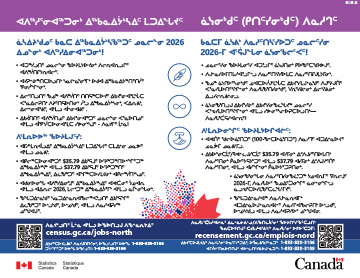Data Stories – Toronto
The economy is more than numbers and forecasts—it's the pulse of our communities, the foundation of opportunity, and a reflection of how we adapt to uncertainty. From inflation and trade pressures to population growth and urban development, Canada's economic story is evolving rapidly. In light of these transformations, do we need to rethink how we understand and respond to economic change?
Join the Chief Statistician of Canada, André Loranger, and a panel of experts for an in-person, data-driven discussion on the theme "Canada at a Crossroads: Resiliency, Adaptability and Change." Presented in partnership with Glendon College on Glendon Campus at York University this session will explore the major socio-economic shifts of the past five years, with a particular focus on Toronto and the province of Ontario. Topics will include Gross Domestic Product (GDP) trends, labour market dynamics, business challenges, and the demographic forces shaping our future.
An expert panel discussion and question period will follow immediately after the presentation. Participants are encouraged to share their perspectives on this vital topic.
We hope you'll join us for what promises to be a compelling and insightful conversation.
When: Tuesday, October 28, 2025, 1:00 pm - 3:00 pm EST
Where: Glendon College, Glendon Campus at York University, Room YH A100 (York Hall at Centre of Excellence)
2275 Bayview Avenue, North York, ON
Cost: Free
Registration: Registration is closed
Presenter and Panellist
André Loranger, Chief Statistician of Canada, Statistics Canada
Host
Carmen DaRosa, Director, Engagement and Data Services, Statistics Canada
Moderator
Jennifer Withington, Assistant Chief Statistician – Economic Statistics Field, Statistics Canada
Panellists
Daniel Brown
Chief Economist and Assistant Deputy Minister, Office of Economic Policy (OEP)
Ontario Ministry of Finance

Daniel Brown was appointed Chief Economist and Assistant Deputy Minister of the Office of Economic Policy (OEP) at the Ontario Ministry of Finance in April 2022. In this role, he leads the development of economic analysis, forecasting, and policy advice for the Ontario government, while also playing a central role in shaping statistical policy across the Ontario Public Service. His appointment builds on a distinguished career in both public and private sectors, with over two decades of leadership in economics, finance, and policy.
Prior to joining the Ontario Public Service, Daniel held senior roles within the United Kingdom's Civil Service, most recently as Director of Economics, Markets and Strategy at the Office of Rail & Road, the UK's independent transport regulator. He began his career at Her Majesty's Treasury, contributing to budget planning, business taxation, and economic modelling. In the private sector, he worked in private equity fundraising and investment, helping to launch OECD-focused infrastructure funds for 3i Group plc and advising major pension funds on infrastructure investment strategies.
Robert Hogue
Assistant Chief Economist
RBC

Robert Hogue is a member of the RBC Economics team, responsible for providing analysis and forecasts on the Canadian housing market and provincial economies. His publications include Housing Trends and Affordability, Provincial Outlook and provincial budget commentaries. In his functions, he is frequently called to comment on the economy both internally within RBC and externally with clients and the media.
Robert joined RBC in May 2008 after spending 15 years with another Canadian financial institution as a senior economist specializing in industrial analysis. At the outset of his career, he spent four years as an economist with Ontario Hydro, where he specialized in industrial and macroeconomic analysis. Robert holds a master's degree in economics from Queen's University and a bachelor's degree from Université de Montréal.
Meredith Lilly, PhD
Professor and Simon Reisman Chair in International Economic Policy
Norman Paterson School of International Affairs, Carleton University

Dr. Meredith Lilly is a full Professor and Simon Reisman Chair in International Economic Policy at Carleton University's Norman Paterson School of International Affairs. Her research focuses on North American trade relations, Canada's trade diversification strategy, economic sanctions, and the use of research evidence in policy making. Prior to her appointment at Carleton, she served as Foreign Affairs and International Trade Advisor to Canadian Prime Minister Stephen Harper. She was previously appointed at the University of British Columbia Okanagan and has worked in policy roles in several Canadian government departments. She engages regularly with foreign governments and diplomats and is a frequent media commentator on North American trade issues.
She is a member of C.D. Howe Institute's International Economic Policy Council, a non-resident scholar at Rice University's Baker Institute for Public Policy in Texas, an Advisory Board member for the Canadian Global Affairs Institute, and serves as the Academic Partner for Canada's delegation to the North American Forum.
Expertise: Canada-US relations; international trade policy; free trade negotiations; labour economics; economic sanctions.




 Download PDF version (98.06 KB)
Download PDF version (98.06 KB) Download PDF version in Inuktitut (South Baffin and Nunavimmiutitut) (79.05 KB)
Download PDF version in Inuktitut (South Baffin and Nunavimmiutitut) (79.05 KB)